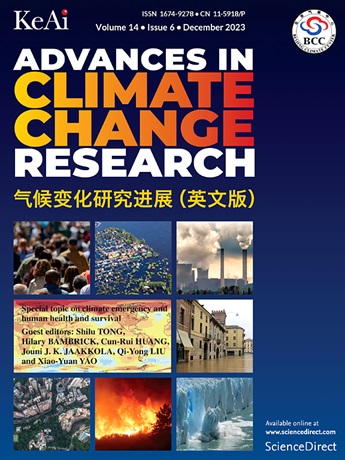Declining autumn zero-curtain duration in the Headwater Area of the Yellow River (2011–2024)
IF 5.2
1区 地球科学
Q1 ENVIRONMENTAL SCIENCES
引用次数: 0
Abstract
The zero-curtain period (ZCP), occuring during seasonal freeze‒thaw cycles, plays a crucial role in energy and water exchanges, biogeochemical and hydrological cycles, and ecosystem dynamics. However, its temporal variations and controlling factors remain poorly understood, particularly in high-altitude regions of the Qinghai‒Xizang Plateau (QXP). This study investigates the ZCP within seasonal freeze‒thaw cycles in the central Headwater Area of the Yellow River (HAYR), using high-precision soil temperature observations from two seasonally frozen ground sites (TCM-2 and ZLH-WS) in 2011–2024. Results demonstrate that at TCM-2, the thawed duration generally decreases with depth, ranging from 163.2 d at 200 cm to 183.6 d at 20 cm, with no significant temporal trends. At ZLH-WS, the thawed duration was 13.2–33.8 d longer than that at TCM-2 but exhibits a distinct decreasing trend in 2016–2023. ZCP duration exhibits strong, albeit contrasting, correlations with soil water storage (SWS) at both sites, negative at TCM-2 (R = −0.86, p < 0.01) and positive at ZLH-WS (R = 0.83, p < 0.01). Notably, the highest recorded soil unfrozen water content in 2019 corresponded to an extended ZCP duration. ZCPs were observed during both thawing and freezing periods. The duration of the freezing period ZCP showed a marked temporal decline, particularly near the maximum frost penetration (MFP) depth and becoming more pronounced at greater depths. A substantial reduction in ZCP duration was detected in the middle and lower portions of the MFP at both sites, with decreasing rates of −1.86 d per year (p < 0.001) at TCM-2 and −2.7 d per year (p < 0.001) at ZLH-WS. These findings suggest that the shortening ZCP altered subsurface water phase dynamics, potentially leading to reduced water retention capacity within the shallow frozen ground profile. This highlights the significant implications of ongoing frozen ground degradation for subsurface hydrology in seasonally frozen ground.
黄河源区秋季零幕持续时间下降趋势(2011-2024年)
零幕期(zero-curtain period, ZCP)发生在季节性冻融循环中,在能量和水分交换、生物地球化学和水文循环以及生态系统动力学中起着至关重要的作用。然而,其时间变化及其控制因素尚不清楚,特别是在青藏高原的高海拔地区。利用TCM-2和ZLH-WS两个季节冻土站点2011-2024年的高精度土壤温度观测资料,研究了黄河中源区季节性冻融循环中的ZCP。结果表明:在TCM-2,解冻时间随深度的增加而减小,从200 cm处的163.2 d减小到20 cm处的183.6 d,没有明显的时间变化趋势;ZLH-WS冻融时间比TCM-2冻融时间长13.2 ~ 33.8 d,但2016 ~ 2023年冻融时间呈明显减少趋势。在两个站点,ZCP持续时间与土壤储水量(SWS)表现出强烈的相关性,尽管存在差异,但在TCM-2站点呈负相关(R = - 0.86, p <;0.01), ZLH-WS阳性(R = 0.83, p <;0.01)。值得注意的是,2019年记录的最高土壤未冻水含量与ZCP持续时间延长相对应。在解冻和冻结期间均观察到zcp。冻结期的持续时间ZCP呈现出明显的时间递减趋势,特别是在最大冻透深度附近,越深越明显。在两个地点的MFP中下部都检测到ZCP持续时间的大幅减少,每年减少- 1.86 d (p <;0.001),每年- 2.7 d (p <;0.001)在ZLH-WS。这些发现表明,缩短的ZCP改变了地下水相动力学,可能导致浅层冻土剖面的保水能力降低。这突出了季节性冻土持续退化对地下水文的重要影响。
本文章由计算机程序翻译,如有差异,请以英文原文为准。
求助全文
约1分钟内获得全文
求助全文
来源期刊

Advances in Climate Change Research
Earth and Planetary Sciences-Atmospheric Science
CiteScore
9.80
自引率
4.10%
发文量
424
审稿时长
107 days
期刊介绍:
Advances in Climate Change Research publishes scientific research and analyses on climate change and the interactions of climate change with society. This journal encompasses basic science and economic, social, and policy research, including studies on mitigation and adaptation to climate change.
Advances in Climate Change Research attempts to promote research in climate change and provide an impetus for the application of research achievements in numerous aspects, such as socioeconomic sustainable development, responses to the adaptation and mitigation of climate change, diplomatic negotiations of climate and environment policies, and the protection and exploitation of natural resources.
 求助内容:
求助内容: 应助结果提醒方式:
应助结果提醒方式:


